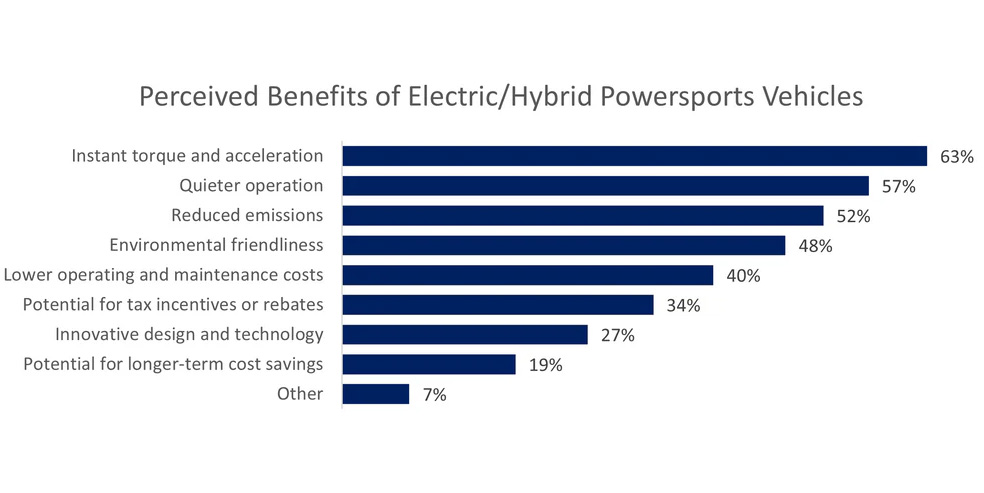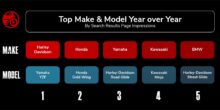Survey: Motorcyclists share views on electric/hybrid powersport vehicles
The powersports industry is at a pivotal crossroads. We recently conducted a comprehensive survey to gauge the sentiments of motorcycle riders regarding the industry’s future. This survey, encompassing a wide range of riders, sheds light on their thoughts and perceptions about current and emerging trends within powersports.
A standout insight from this survey is the evolving attitude towards electric and hybrid powersport vehicles. This trend signals a significant shift in the industry, reflecting broader global movements towards sustainability and advanced technology. With 67% of riders viewing the impact of global trends like eco-friendliness and digital innovation, it’s clear that the industry is on the cusp of transformative change.
Insights from riders
While there’s an underlying excitement about the potential of electric powersport vehicles, riders are also considering what these changes mean for the essence of their passion. This isn’t just about swapping a gasoline engine for a battery; it’s about how it alters the experience of riding through rugged terrains, open fields, or along winding roads.
Key concerns voiced by riders include practical aspects like the range limitations of electric vehicles, the availability and speed of charging facilities, especially in less accessible areas, and the overall reliability of these vehicles in more demanding environments. These are not minor considerations; they speak directly to the heart of what makes powersports appealing: the freedom to explore without bounds.
However, it’s not all about the challenges. Riders also express a curiosity about the new dimensions that electric and hybrid vehicles might bring to their experience. There’s an acknowledgment that these technologies could open up new possibilities in terms of performance, environmental impact, and even the nature of the rides themselves.
Advantages of electric/hybrid vehicles
A standout advantage is the instant torque and acceleration that electric motors provide. This characteristic is particularly appealing to riders who are accustomed to the immediate response and power of traditional engines but are curious about the different kind of performance electric vehicles promise. The potential for a new style of riding experience, where power delivery is both immediate and smooth, is an exciting prospect.
The quieter operation of electric and hybrid vehicles is another significant benefit. While the iconic sound of a gasoline engine has its appeal, the prospect of a less noisy ride is becoming increasingly attractive, especially for those who enjoy riding in natural settings. Furthermore, the environmental benefits of reduced emissions are not lost on the riders. As global awareness of environmental issues grows, the powersports community is also reflecting on its role in this larger conversation. The shift towards electric and hybrid vehicles is seen not just as a technological advancement but also as a step towards more sustainable and responsible riding practices.
In embracing these advantages, riders are not looking to replace the essence of traditional powersports but to augment it with new, innovative experiences.
The decade ahead
The transition to electric and hybrid vehicles in the powersports industry is not just about adopting new technologies; it’s also about meeting and exceeding the performance standards set by traditional internal combustion engines. Riders have specific expectations in this regard, reflecting a blend of hope for the future and a deep understanding of current capabilities.
A notable insight from our survey is that a considerable number of riders anticipate that electric and hybrid powersports vehicles will surpass traditional engines in many areas. This expectation is anchored in the perceived potential of electric technology, especially when it comes to delivering efficient and robust acceleration. Riders are looking forward to seeing how these advancements translate into real-world riding experiences.
Despite this optimism, there’s a grounded understanding among the community. Riders acknowledge the current limitations of electric and hybrid vehicles, particularly in terms of infrastructure development, range, and charging efficiency. These are seen as hurdles that need to be overcome to fully realize the potential of these new technologies in the powersports context.
Looking ahead, riders are hopeful yet realistic about the timeline for these advancements. Many believe that the next decade will be crucial for the development and refinement of electric and hybrid vehicles in the powersports industry. This period is seen as a window of opportunity for significant strides in technology, potentially reshaping the powersports experience – and attracting new riders to the industry.
This balanced view of anticipation and realism reflects the riders’ deep connection to their sport and their openness to technological evolution, setting the stage for a dynamic decade of innovation and growth in the powersports industry.
Charting the course
As the powersports industry stands on the brink of a significant shift towards electric and hybrid technologies, charting a strategic course forward is imperative. This involves concerted efforts from various stakeholders, each playing a unique role in shaping the future of the industry.
Manufacturers have a pivotal role in driving this change. Beyond just integrating electric and hybrid technologies, they need to innovate in ways that address the specific concerns of riders, such as range, charging infrastructure, and maintaining the thrill of the ride. This could involve developing new battery technologies, efficient motors, and designs that resonate with both traditional enthusiasts and new riders.
Dealers and marketers are on the front lines of customer interaction and education. Their role in familiarizing riders with the benefits and capabilities of electric and hybrid powersports vehicles is crucial. Effective marketing strategies should not only focus on the environmental benefits but also emphasize the performance, convenience, and unique riding experiences these vehicles offer.
Policymakers play a supportive role by creating a conducive environment for the growth of electric and hybrid powersports. This includes offering incentives for buyers (e.g., IRC Section 30D(g) Qualified 2−Wheeled or 3−Wheeled Plug-in Electric Drive Motor Tax Credit), investing in charging infrastructure, and formulating regulations that encourage sustainable manufacturing practices. Considering the specific needs of powersport vehicles in policy-making, especially in off-road and recreational areas, is vital.
Riders themselves are integral to this transition. Their openness to new technologies, willingness to provide feedback, and adaptability will shape the industry’s direction. Embracing change while preserving the essence of powersports is key to the community’s evolution.
Environmental and Industry Advocates can work together to find a balance between ecological concerns and the thrill of powersports. Collaborative efforts can lead to innovative solutions that promote sustainability without compromising the essence of the sport.
It’s essential for these stakeholders to work in unison. By addressing the concerns, leveraging advancements, and creating a supportive ecosystem, the powersports industry can move towards a future that is both exciting and sustainable.













